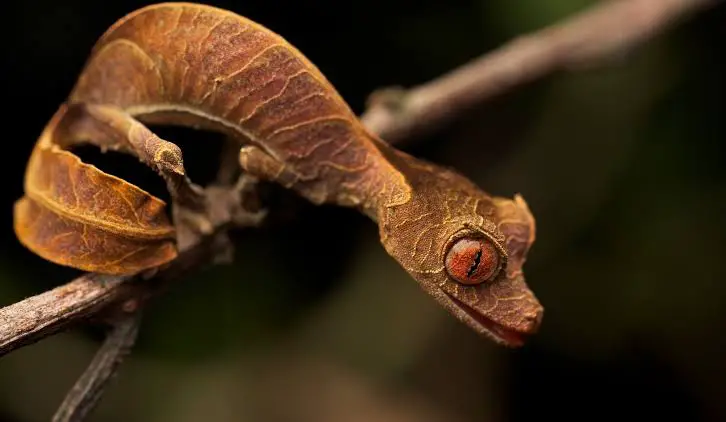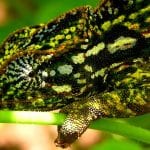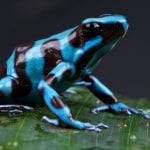The island of Madagascar is home to a lot of strange and rare creatures that can somewhat be too odd and exotic for the lot of us. However, for the people and the animals living on that island, seeing some of those creatures on a daily basis has become a norm for them. In our case, we do not normally get to interact with such rare animals, and we most likely do not know how to properly care and handle them when given a chance to do so.
The Leaf-Tailed Gecko is one of those rare and unique animals that can be somewhat a bit alien to most of us, especially because we probably have never seen or encountered anything remotely similar to it. This animal can only be found in the eastern portion of Madagascar and is extremely difficult to spot because of its unique survival capabilities.
In the United States and in many other American countries, the Leaf-Tailed Gecko has been introduced as a rare and exotic pet for those who prefer keeping the most unusual types of reptiles. However, since it is an animal that is native to the island of Madagascar, it is extremely difficult to not only find but also take care of in most domestic houses especially if you do not know the best way to handle them or if you have no prior experiences in taking care of exotic reptiles.
Because many experts believe that the Leaf-Tailed Gecko can be one of the most challenging types of reptiles to take care of, the consensus is that this is an animal that should be better off left as display and exhibit specimen rather than something you would like to handle on a regular basis. But if you really want to learn how to take care and handle these animals like an expert, do not fret because we have put together a guide on how to feel like a reptile master with your Leaf-Tailed Gecko.
What is the Leaf-Tailed Gecko?
Physical description
The Leaf-Tailed Gecko is a species of reptile that is native to the island of Madagascar and can be mostly found in the island’s eastern portion. These animals are usually around 4 inches long in terms of its overall length from its head up to its tail. Its giant variety, however, can be as large as 12 inches long and is only one of more than a dozen subspecies that belong to the Uroplatus genus.
While the Leaf-Tailed Gecko may have different subspecies that each have their own unique quirks and physical descriptions, what is usually consistent among them is the patented tail that gives them their name. There is no mistaking the fact that the Leaf-Tailed Gecko’s tail really looks like a dead leaf as generations of natural selection have allowed this reptile to imitate leaves in an almost perfect fashion that is too hard to dismiss. The fact that the tail is also complete with vein-like lines around it, a rough skin texture, and missing chunks that may look like real leaves that have been eaten by insects only completes the entire ensemble and perfects how well this reptile has imitated a true dead leaf to help it with its survival capabilities in the wild.
One trait that is common between the Leaf-Tailed Gecko and all of the other species of Geckos is that they have no eyelids. Instead, what these lizards do is to use their tongue to clean and moisten their eyes whenever they get too dirty or dry. Their tongues are so mobile that they can easily reach the eyes to wipe off any kind of dust or small debris that may get into the eyes.
Leaf-Tailed Geckos can come in different colors and usually do not have distinctive colors that some geckos or lizards usually have. In that case, these reptiles come in colors that include purple, yellow, brown, tan, orange, and other colors that are similar to close to those shades. However, because the Leaf-Tailed Gecko is an expert at camouflaging itself, it can be pretty difficult to truly tell what its real color is whenever it is blending with its surroundings.
Behavior

The Leaf-Tailed Gecko can be both nocturnal and crepuscular. Nocturnal means that is active when the sun is down. Crepuscular means that this lizard can also be active during both dawn and dusk. However, the Leaf-Tailed Gecko is more of a nocturnal animal as it is more active at dusk than dawn because of how doing so allows them to hunt for their prey easily while avoiding all sorts of different predators that are mostly active during either the day or the night.
As a way for it to avoid getting detected by predators, they have the ability to stay hidden on tree branches and among dead leaves while blending together with their surroundings expertly. As such, this type of lizard tends to be really difficult to find in the wild, especially if you do not know how to detect them. They can stay motionless the entire day while resting before starting to become more active when the sun goes down. In some cases, the larger subspecies of these lizards can flatten their bodies against trees, all while sleeping the entire duration.
The reasons why they are so adept at staying hidden during the day is to fool diurnal predators that cannot tell them and the threes and leaves apart from one another. Some of the Leaf-Tailed Gecko’s natural predators include birds of prey, snakes, rats, and bigger lizards. But, even when they are detected by their predators, they are not easy to back down as they may try to fight off threats by displaying their reddish mouths while emitting a loud cry to try to intimidate its foe. And if it is on the losing side of things, this gecko can simply run away and allow its tail to get lopped off because it can always grow back that leaf-shaped tail it is very popular for.
Eating habits
The Leaf Tailed Gecko is a crepuscular insectivore that hunts for insects during dawn and dusk but is more active during the night time due to how there are fewer predators awake at that time. As insectivores, they will only feed on insects of any kind so long as their prey is small enough for them to dominate. In other words, they do not care what kind of insect that is as long as they are not too big for this reptile to handle. They will eat spiders, cockroaches, flies, crickets, snails, and worms so long as the Leaf-Tailed Gecko is the bigger one in the encounter between those two animals.
However, if you are talking about the large subspecies of Leaf-Tailed Geckos, the gigantic variety that can be about 12 inches long will not only eat insects of any kind but will also eat mice. Again, as long as this lizard is larger than its potential prey, it will eat it regardless of what kind of animal it may be.
Handling and Caring for the Leaf-Tailed Gecko
Cage
The Leaf-Tailed Gecko is mostly arboreal in the sense that it prefers to stay on elevated spots than on the ground. That means that caging it requires you to place it in an enclosure that is oriented vertically instead of horizontally. A cage that is about 1 to 2 feet in terms of height can be good enough for this lizard. Larger subspecies should be kept in cages that are at least 2 feet high. It should be noted that the cage is best made out of acrylic on all sides but one. The front should be a screen to promote airflow and humidity. You can safely place more than one of these geckos in the same enclosure as long as the cage is large enough to house them. Males are not too aggressive to their fellow males as long as the conditions in their habitat are fine enough for them to live together in harmony.
Providing areas where the Leaf-Tailed Gecko can perch should be a top priority for you because of their arboreal tendencies. As much as possible, you can use natural branches or PVC to provide branch-like structures where the gecko can perch on.
Heating and lighting
The enclosure of the Leaf-Tailed Gecko should be warm enough for them because of how they are used to the tropical climate of Madagascar. Ambient air temperatures should be about 75 degrees Fahrenheit. Meanwhile, a basking area that is as warm as 82 degrees should also be provided. You can provide them with the light and the warmth they require by placing a lizard bulb inside the enclosure. They do not require UVB lighting because of their nature as nocturnal animals.
Food
Leaf-Tailed Geckos are insectivores that can eat any insects smaller than they are. However, there are not a lot of things known about these geckos as it is widely believed that they only eat insects and other invertebrates because there are bigger subspecies of this animal that can actually eat rodents that are small enough for them to safely eat.
So, for those who are keeping these reptiles in captivity, it is safe to assume that you can feed them any kind of animal that is small enough for the Leaf-Tailed Gecko to dominate. Some would prefer to feed them with worms and crickets because of how easily accessible these insects are. However, the gigantic variety may be able to feed on pink mice or even adult-sized mice.
Water
Leaf-Tailed Geckos do not drink water directly from a source. Instead, in the wild, they prefer to drink water falling from leaves whenever it rains. In your case, it will be useless to place a water dish inside their enclosure. You should instead mist the enclosure on a regular basis to allow water drops to fall naturally from the branch-like structures you placed in the cage. But you can also provide a water dish inside the enclosure just in case. The water dish also aids in making the entire cage more humid.
Handling the Leaf-Tailed Gecko

The Leaf-Tailed Gecko is said to be an animal that should only be for the eyes and not for the hands because this lizard tends to be quite difficult to handle even for seasoned reptile breeders and pet owners. That is why some experts believe that handling this animal should be kept at a minimum of about once a week to make sure that they do not get too stressed out whenever you are handling them.
As an animal that can be quite shy and seemingly defensive, the Leaf-Tailed Gecko displays a jumpy personality due to how it loves to stay hidden from potential threats and predators as much as possible. The only time that you should try to handle this animal is when it is absolutely necessary for you to do so. If you try to handle it just because you simply want to, there is a good chance that it will get stressed out and may even fall ill or die due to the stress that handling it caused. If you want a specimen that is easier to handle, go for captive-bred ones because of how they are much more receptive to handling and due to how they are not as exposed to the dangerous conditions of the wild compared to their wild-caught counterparts. However, just because they are more receptive to getting handled, it does not mean that you should just handle them unnecessarily. Again, try to minimize handling to about once or twice a week or whenever it really is necessary to do, so such as when you are cleaning out the Leaf-Tailed Gecko’s cage.



